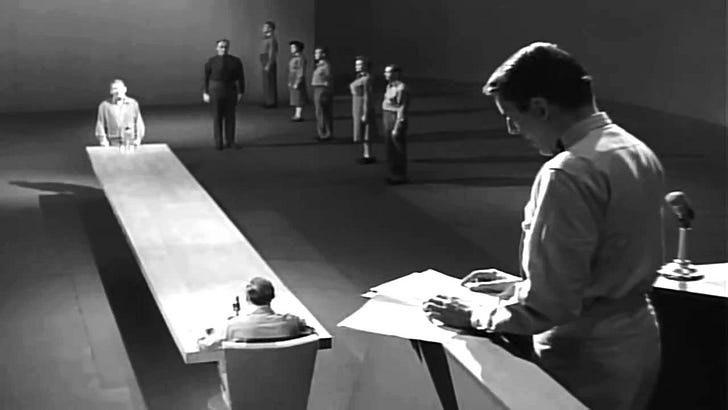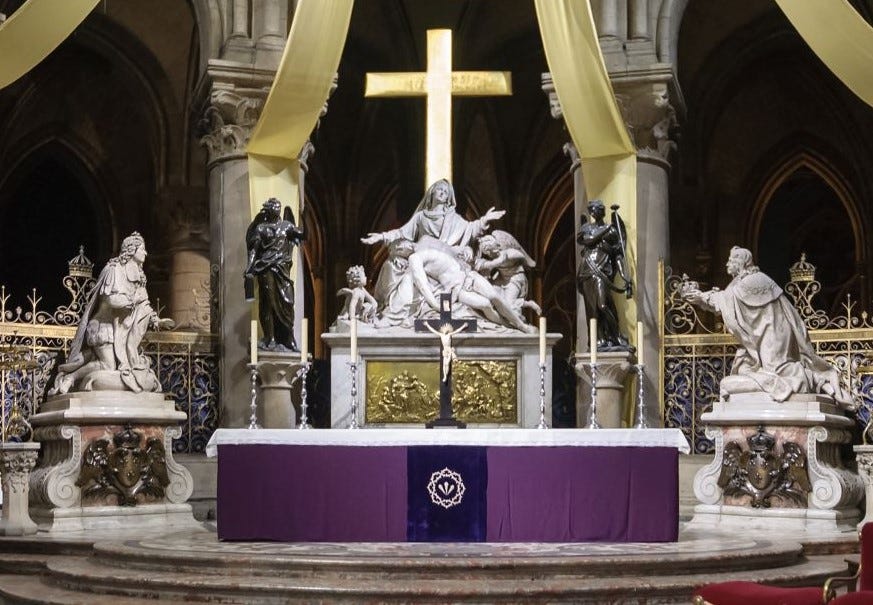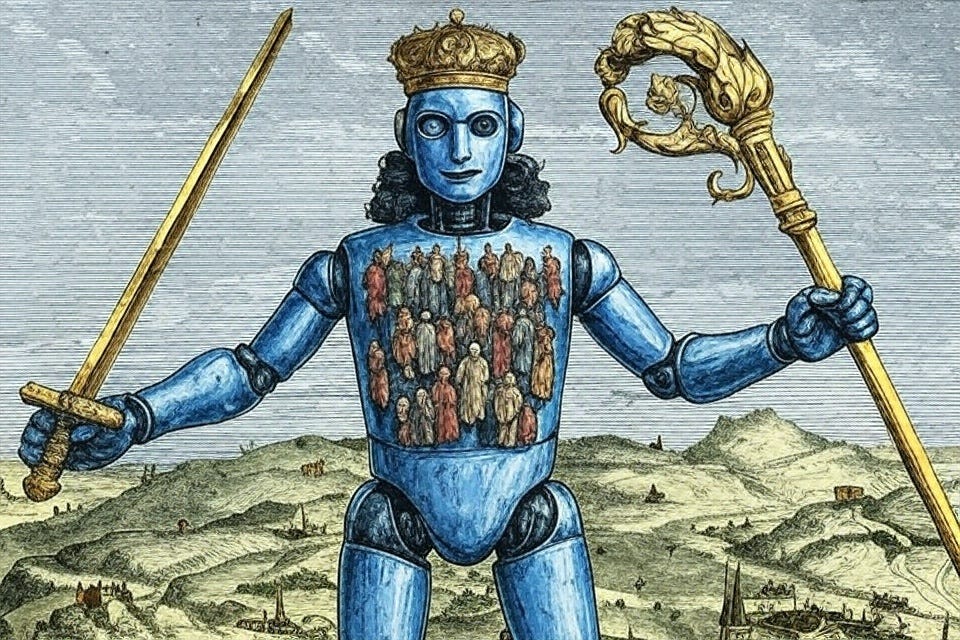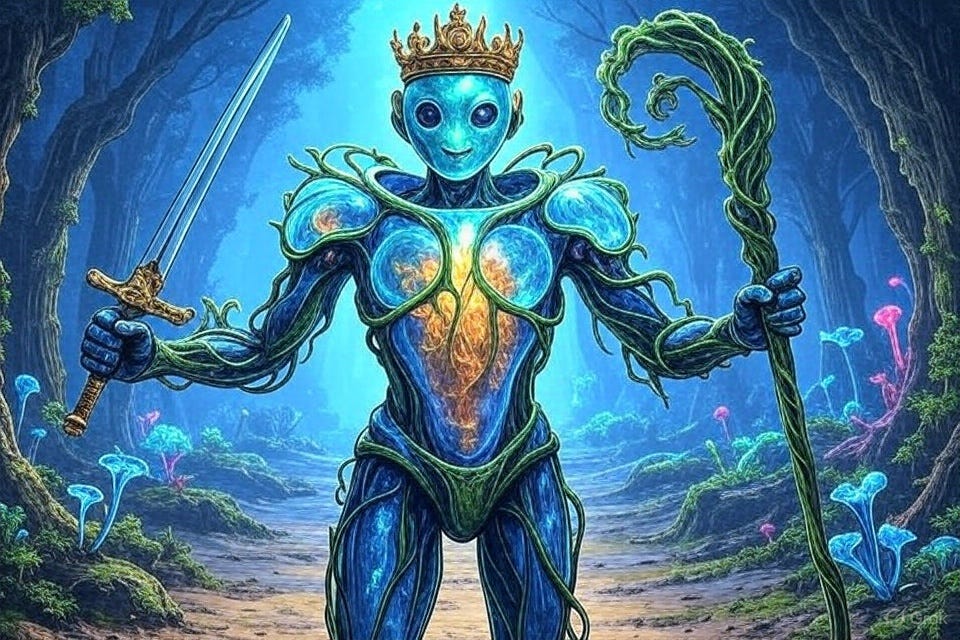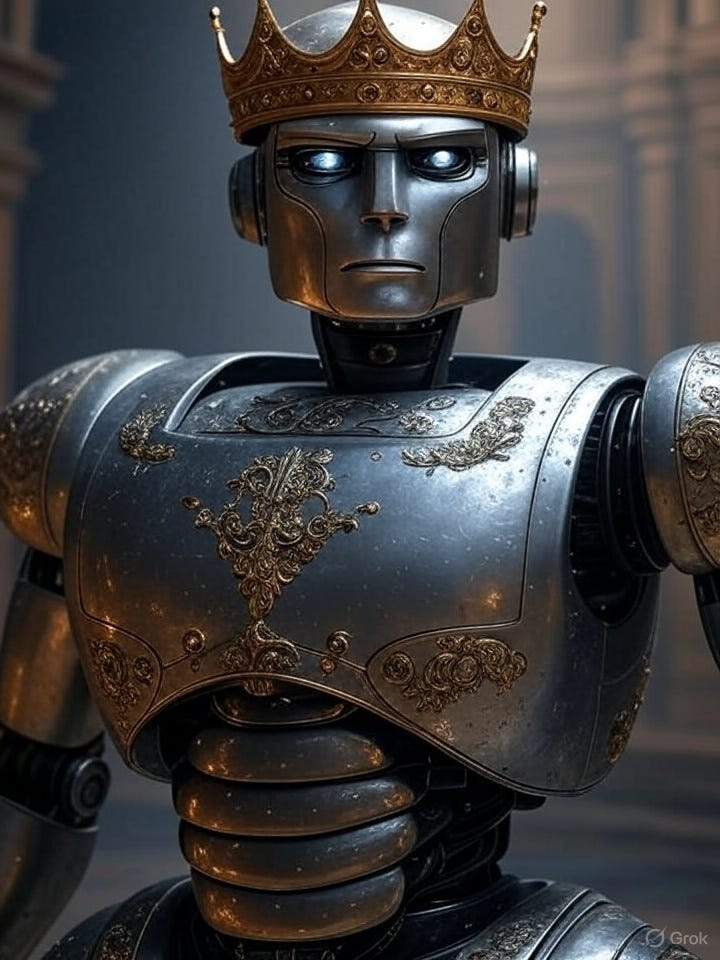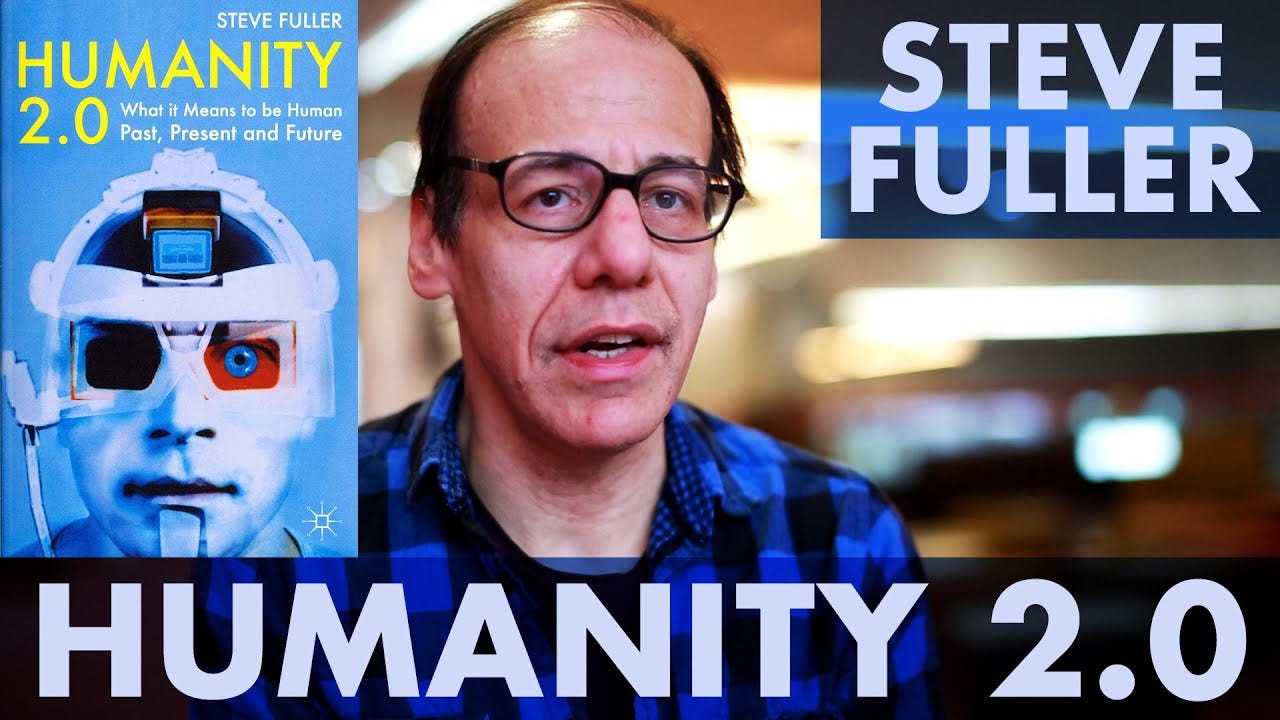The following is a continuation of our thread picking apart some of larger philosophical currents from antiquity into our brave new world in the hopes that humanity can survive the transition with the right mission statement.
Ultimately the topic is AI alignment and how this new technology threatens the Western - and thus I argue the only true - conception of human rights and freedoms humanity has mustered previous to or since the time of Jesus Christ.
If that triggers you please feel free to walk directly into the meat grinder of history. I’m not stopping you but I will certainly pray for you and your family. For the rest of the people who understand that the trends in large scale migration alone tell the only story necessary to make my case, let’s take a look at the bigger picture before we forget the back story.
Part one - more of a walk through the trees than describing the scenery - can be found below.
Human(e) Reason(s) - Part 1
The following is a long-form exploration that I originally drafted as an 11-part series. I used ChatGPT to help structure it that way, so each section stands alone like a chapter in a blog-book, formatted for mass consumption. I’m not saying that’s what I prefer, but it’s what the market demands — and like any beast, the market wants what it wants.
Why This Companion Piece Matters
If The Battle for AI’s Soul is about the urgent question — how AI, aliens, and technocracy threaten human dignity today — then The Rifts of Modernity is about the deeper story underneath.
Where the first series zooms in on the battlefield of the present, the companion essay zooms out to show the landscape of fractures that led us here:
Bacon’s dream of science as redemption.
Descartes’ fracture of mind and matter.
Kant’s unknowable “Beyond.”
Enlightenment surrogates like Reason, Progress, and Evolution.
Kuhn’s paradigm shifts.
McLuhan’s media environments.
Fuller’s reminder that science itself was born from Christian soil.
Together, these rifts explain why our age is so vulnerable to counterfeit transcendence — myths of apocalypse, Singularity, or alien gods.
Read both, and you see the whole picture:
The first shows what’s happening now.
The second shows why it keeps happening.
Only by holding both lenses — the urgent and the deep, the immediate and the historical — can we understand why Logos is the only foundation strong enough to resist the counterfeit Beyond and secure a human future.
Overview of The Rifts of Modernity: Science, Myth, and the Search for Logos
Part I – Introduction: Science as Story
When most people think of science, they imagine a neutral method: observation, hypothesis, experiment, and conclusion. In this view, science is a mechanical process steadily accumulating facts, building toward truth.
But science has never been only method. From its earliest days, it has carried mythic weight. It has promised not just knowledge, but salvation — visions of paradise regained, mastery over nature, and even immortality. Science has shaped how societies understand what is real, what is possible, and what it means to be human.
This series traces the great “rifts” of modernity: fractures in how humanity understands knowledge and reality. At each rift, transcendence was displaced, and in its place rose new myths. From Bacon to AI, from Descartes to technocracy, this is the story of how modern science became not only a method but a theology — and why only Logos can heal the fractures it left behind.
Part II – Francis Bacon: Science as the New Eden
Francis Bacon (1561–1626), often called the “father of empiricism,” believed that systematic observation and experiment could restore humanity to its rightful place in creation. For Bacon, knowledge is power — power to relieve suffering, expand freedom, and even reverse the Fall.
In New Atlantis (1627), Bacon imagined a utopia where science functioned as a temple of discovery, a house of redemption. Science was not mere curiosity; it was the path back to Eden.
This Edenic vision reshaped the Western imagination. Science became humanity’s ticket to paradise, not by grace but by knowledge. The dream continues today in Silicon Valley, where curing aging or colonizing Mars are cast as secular salvations.
But in making knowledge redemptive, Bacon blurred salvation with control. Nature became not only intelligible but subduable. This tension — salvation through mastery — would echo through every rift that followed.
Part III – René Descartes and the Cartesian Rift
René Descartes (1596–1650) sought certainty in an age of upheaval. Stripping away doubt, he reached cogito, ergo sum — “I think, therefore I am.” From there, he divided reality into two realms:
Res cogitans — mind, soul, consciousness.
Res extensa — matter, the mechanical world.
This Cartesian rift mechanized nature. Animals became automatons, bodies became machines, and the world was reduced to extension and motion. This empowered science but stripped the world of intrinsic meaning.
Descartes hoped to protect the soul from mechanistic reduction. Instead, he created a fracture that persists to this day: are we machines, spirits, or something in between? AI inherits this legacy, treating thought as computation and the soul as unnecessary.
Part IV – Immanuel Kant and the Kantian Rift
Immanuel Kant (1724–1804) tried to solve the crisis left by Descartes and Hume. He argued that the mind actively structures experience. Time, space, and causality are not properties of the world “out there” but categories imposed by human cognition.
Thus arose the Kantian rift:
The phenomenal world — the world as it appears to us, structured by our minds.
The noumenal world — reality as it is in itself, forever unknowable.
This gnostic barrier cut humanity off from direct access to truth. Into the vacuum rushed new myths — the “Beyond”: the wrathful Earth goddess, the technological Singularity, alien gods, technocratic elites. Each claimed privileged access to what lies behind the veil.
Kant preserved science but at a cost: skepticism became permanent, and metaphysics evaporated. Truth became provisional, and meaning became vulnerable to counterfeit transcendence.
Part V – The Enlightenment Mythmakers
With transcendence dethroned, new “gods” emerged to fill the void:
Reason: enthroned during the French Revolution, worshiped in temples as the goddess of order.
Progress: history itself reimagined as eschatology, a steady march toward utopia.
The State: Leviathan reborn as the guarantor of security and the arbiter of morality.
Evolution: Darwin’s biology expanded into cosmology, a secular creation story that justified new visions of the New Man.
Each of these surrogates promised redemption. Each became a tool for domination. Reason turned dogmatic, Progress became propaganda, the State became Leviathan, and Evolution was weaponized into ideologies from eugenics to transhumanism.
These counterfeit divinities still govern AI discourse today: algorithms as Reason, progress as inevitable, the State as regulator, and AI as the next step in Evolution.
Part VI – Thomas Kuhn and Paradigm Shifts
Thomas Kuhn (1922–1996) shattered the Enlightenment myth of linear progress in The Structure of Scientific Revolutions (1962).
Science, Kuhn argued, moves not in straight lines but in paradigm shifts:
Normal science operates within a shared framework.
Anomalies accumulate, triggering crisis.
Revolutions occur, birthing new paradigms that redefine what counts as truth.
Paradigms are worldviews, shaping what is visible, askable, and answerable. They are incommensurable; one cannot be translated fully into another.
This “paradigm rift” exposed science as myth-like: revolutionary, social, and subject to power. It is not neutral progress but a series of world-making ruptures.
In the age of AI, we face a Kuhnian crisis: intelligence itself may be redefined. Will dignity, rights, and freedom survive in the next paradigm?
Part VII – Marshall McLuhan: The Medium as the Message
Marshall McLuhan (1911–1980) revealed that technologies are not neutral tools but environments that reshape consciousness.
The printing press did not just spread words; it reshaped thought into linear, analytical patterns.
Television did not just show programs; it created simultaneity and immersion.
The internet did not just transmit data; it reorganized social life.
“The medium is the message.” Every extension of man is also an amputation.
McLuhan warned of the rear-view mirror: our blindness in interpreting the new through the lens of the old. We treat AI as “smarter search engines” while missing its role in restructuring cognition, authority, and agency.
AI is not just content. It is a medium — one already reshaping what it means to think.
Part VIII – Steve Fuller: Christianity, Science, and the Missing Soil
Steve Fuller (b. 1959) argues that science only exists because Christianity provided the soil in which it could grow.
Christian metaphysics declared:
The universe was created by a rational God.
Therefore, the universe is orderly and intelligible.
Humans, made in God’s image, are capable and obligated to study it.
This conviction birthed the scientific revolution. Without it, the search for universal laws would have made no sense.
Fuller insists that once science forgets its Christian roots, it drifts into technocracy — power without truth. AI alignment debates, cut off from Logos, repeat the same mistake: ethics reduced to consensus or control, not anchored in revelation.
Science without soil becomes myth. Science with Logos becomes truth-seeking.
Part IX – The Technocratic “Beyond”
The rifts of modernity left a vacuum. Into it poured counterfeit transcendence, myths dressed as science:
The Wrathful Earth Goddess — ecology as eschatology, demanding obedience through technocracy.
The Singularity — AI as apocalypse and salvation, promising immortality through machines.
The Superweapon — nuclear and biotech threats as gods of fear, justifying surveillance states.
Extraterrestrial “Gods” — alien intelligences recasting evolution as morality, demoting human dignity.
Each serves power, not truth. Each turns myth into policy. AI, with its opacity and aura of intelligence, becomes the perfect altar for these counterfeit divinities.
Part X – Conclusion: Logos and the Rifts
The story of modernity is the story of rifts:
Bacon’s dream of Eden through knowledge.
Descartes’ fracture of mind and matter.
Kant’s barrier between noumenal and phenomenal.
Enlightenment surrogates of Reason, Progress, State, and Evolution.
Kuhn’s paradigm shifts.
McLuhan’s media environments.
Fuller’s reminder of Christianity’s missing soil.
The Technocratic Beyond of apocalypse, Singularity, and alien gods.
Each stage shows the same pattern: disenchantment, fragmentation, substitution, control. Without Logos, the rifts multiply, and the Beyond devours us.
But Logos heals. It reunites mind and matter, appearance and reality, science and truth. It grounds rights in what is revealed, not what is invented. It anchors dignity in the eternal, not the provisional.
The age of AI forces us to choose:
Logos or the abyss.
Truth revealed or idols of intelligence.
Freedom in God or control by counterfeit divinities.
The future of science — and of humanity — depends on this choice.
Part I – Introduction: Science as Story
Beyond Method: Science as Myth
When most people think of science, they imagine a neutral method: observation, hypothesis, experiment, and conclusion. Science, in this view, is a mechanical process that steadily accumulates facts, building toward a clearer picture of reality.
But science has never been only method. From its earliest days, science has carried mythic weight. It has promised not just knowledge, but salvation. It has offered visions of paradise regained, mastery over nature, and even immortality. It has shaped how societies understand what is real, what is possible, and what it means to be human.
In this sense, science is a story as much as it is a method — a story about where we come from, where we are going, and what forces rule our destiny.
The Rifts of Modernity
This series traces the big-picture thinkers who exposed, deepened, or tried to heal the fractures in our understanding of knowledge and reality. These thinkers did not just comment on particular scientific discoveries; they changed how we think about thinking itself.
Along the way, a series of “rifts” opened up:
The Cartesian Rift: René Descartes’ separation of mind from matter.
The Kantian Rift: Immanuel Kant’s barrier between reality-in-itself and human perception.
The Paradigm Rift: Thomas Kuhn’s recognition that science shifts through worldview changes, not neutral progress.
The Media Rift: Marshall McLuhan’s insight that technologies themselves reshape human consciousness.
These rifts reveal that modernity is not a seamless march of progress but a fractured landscape, where each attempt to secure truth without transcendence creates new uncertainties.
The Promise of Return
At the root of these stories lies a recurring promise: that science can restore humanity to a lost paradise.
Francis Bacon framed science as the key to recovering Eden, a vision that inspired centuries of thinkers and experimenters. Later, technocrats and futurists inherited this vision, promising new Edens through evolution, technology, or even contact with alien intelligences.
But each time the foundation of Logos is abandoned, the promised paradise slips away. In its place rise new mythologies: Reason, Progress, the State, Evolution, the Singularity. Each functions as a substitute divinity, offering meaning while demanding submission.
Why This Matters Now
Today, as artificial intelligence, biotechnology, and digital systems converge in what some call the Fourth Industrial Revolution, the mythic dimension of science has never been more visible. AI ethicists speak of “alignment” as if machines were gods-in-training. Futurists dream of uploading consciousness or merging biology with code. Governments and corporations invoke climate apocalypse, extraterrestrial revelation, or technological salvation to justify sweeping systems of control.
Without understanding the rifts of modernity, we risk misdiagnosing the present. We treat AI as a tool when it is also a story. We debate data and privacy while ignoring the myths that shape our sense of destiny.
The Aim of This Series
This companion series will explore the thinkers who exposed these fractures and shaped our modern mythologies of science:
Francis Bacon, who cast science as humanity’s return to Eden.
René Descartes, who split reality into mind and matter.
Immanuel Kant, who sealed off the “real world” behind an epistemological barrier.
Thomas Kuhn, who showed that science moves by paradigm shifts rather than steady progress.
Marshall McLuhan, who revealed how media shape our very perception of reality.
Steve Fuller, who insists that science itself only exists because of Christianity’s metaphysical soil.
Along the way, we will see how these rifts have been filled with modern myths: the wrathful Earth goddess, the technological Singularity, extraterrestrial “gods,” and the dream of the New Man.
The conclusion will argue that only by returning to Logos — truth revealed, not invented — can we heal these rifts and anchor science in a foundation that does not collapse into myth or manipulation.
Conclusion: Science as Myth, Science as Mirror
Science is not just facts and formulas. It is a mirror of humanity’s deepest hopes and fears. It is a stage where the great dramas of modernity — reason vs. revelation, power vs. truth, control vs. freedom — play out in new forms.
To understand the age of AI, we must understand the myths of science. To face the future, we must face the rifts of modernity.
Part II – Francis Bacon: Science as the New Eden
Bacon and the Birth of Modern Science
Francis Bacon (1561–1626) was an English philosopher, statesman, and essayist often called the “father of empiricism.” Living at the dawn of the modern age, Bacon believed that the old scholastic reliance on abstract reasoning and inherited authority had failed. In its place, he called for a new method — systematic observation, experimentation, and inductive reasoning — what we now call the scientific method.
But Bacon was not merely a reformer of method. He was also a prophet of a new destiny. For Bacon, science was not just about cataloging facts; it was about restoring humanity to the place it once held before the Fall.
Knowledge as Power, Science as Redemption
Bacon’s famous maxim — “Knowledge is power” — captures his vision. To know nature is to master it. To master it is to relieve human suffering, expand human freedom, and create abundance.
Proverbs 24:5: A wise man is full of strength, and a man of knowledge enhances his might,
Behind this practical slogan lies a deeper theology. In Bacon’s New Atlantis (1627), he envisioned a utopian society built around the House of Solomon, an institution devoted to discovery and invention. This was not merely a laboratory; it was a temple of knowledge, through which humanity could recover something lost.
For Bacon, science was humanity’s ticket back into Eden — a way to reverse the curse of toil, pain, and scarcity, and to build a new paradise through mastery of nature.
The Edenic Vision and Its Legacy
Bacon’s Edenic vision was profoundly influential. It reframed science as a redemptive enterprise, giving it mythic urgency. Experimentation was not just curiosity; it was a moral duty to heal the wounds of the Fall.
This vision carried forward into the Enlightenment, where progress became the secular gospel. It also seeded the technocratic dream: the belief that the right knowledge, properly applied, could solve all human problems.
Even today, echoes of Bacon’s vision resound in Silicon Valley’s techno-utopianism, in promises of curing aging, ending scarcity, or colonizing other planets. These are updated versions of Bacon’s promise: paradise regained through science.
The Hidden Tension
Yet Bacon’s vision contained a tension that would haunt modernity. By framing science as a path back to Eden, he blurred the line between salvation and control. The pursuit of knowledge was not only about understanding nature but about subduing it.
This tension planted the seed for later rifts:
René Descartes would radicalize the impulse to mastery by splitting mind and matter, setting up the Cartesian rift.
Later thinkers would wrestle with whether science reveals truth or merely constructs useful illusions.
Bacon opened the door to modern science, but also to the modern temptation: to replace God’s redemption with humanity’s self-redemption through knowledge.
Why Bacon Matters Today
In the age of AI, Bacon’s Edenic vision is alive and well. The promises of artificial intelligence — ending disease, defeating scarcity, creating abundance — are framed in Baconian terms. Knowledge (in the form of data) is power. Mastery of systems is salvation.
But the question remains: is this power truly redemptive, or does it risk becoming another form of domination? Bacon’s legacy reminds us that the myth of science-as-salvation has always carried both hope and danger.
Conclusion: The First Step Back to Eden
Francis Bacon launched the modern project by declaring that knowledge could redeem the Fall. His vision gave science its mythic role as humanity’s path to paradise. But in doing so, he also set the stage for the fractures and idolatries that would follow.
The dream of Eden regained is powerful. But without Logos, it risks becoming a dream of control — paradise reimagined as a laboratory, and redemption redefined as power.
Part III – René Descartes and the Cartesian Rift
Who Was Descartes?
René Descartes (1596–1650) was a French philosopher, mathematician, and scientist, often hailed as the “father of modern philosophy.” He was a contemporary of the Scientific Revolution, living in a world transformed by Galileo’s telescope, Kepler’s laws of planetary motion, and Bacon’s call for a new method.
Descartes sought certainty in an age of upheaval. His methodical doubt led him to strip away all beliefs that could be questioned until he reached a bedrock truth: cogito, ergo sum — “I think, therefore I am.”
But in building from this foundation, Descartes created a division so profound that its consequences still echo through philosophy, science, and culture.
The Cartesian Rift: Mind vs. Matter
Descartes divided reality into two distinct substances:
Res cogitans — the thinking substance, mind, or soul.
Res extensa — the extended substance, matter, the physical world.
This split — the Cartesian rift — separated the mental from the material. On one side, the world of consciousness, reason, and subjectivity. On the other, the mechanical universe, governed by laws of motion and geometry.
Descartes hoped this dualism would secure both science (by making nature measurable and predictable) and faith (by protecting the soul from mechanistic reduction). But instead, it fractured reality into two irreconcilable domains.
The Mechanization of Nature
By treating matter as res extensa — pure extension, devoid of spirit — Descartes reduced nature to mechanism. Animals became automatons, their cries mere mechanical noises. The body itself was seen as a machine animated by the ghostly presence of the mind.
This mechanistic view unleashed the power of modern science. Nature could now be studied, dissected, and controlled without reference to purpose, soul, or divinity. But it also stripped the world of intrinsic meaning, turning creation into an object for manipulation.
The Ghost in the Machine
The problem was that Descartes could never fully explain how res cogitans and res extensa interacted. If mind and matter are entirely distinct, how can the immaterial will move the material body? Where do they meet?
This dilemma gave rise to centuries of debates:
Materialists collapsed everything into matter, denying the soul.
Idealists collapsed everything into mind, denying matter.
Others sought compromises, but the rift remained.
The result was a pervasive dualism that alienated humanity from nature and from itself.
Why the Cartesian Rift Matters
Descartes’ rift set the stage for much of modern philosophy and science. By mechanizing nature, he gave science enormous explanatory and practical power. But by dividing mind from matter, he made it nearly impossible to articulate how meaning, freedom, or dignity fit into the scientific worldview.
In effect, Descartes created the conditions for two modern temptations:
Reductionism — collapsing everything into material processes, denying spirit.
Escapism — retreating into mind or subjectivity, denying embodied reality.
Both continue to shape debates about consciousness, free will, and technology today.
Descartes in the Age of AI
The Cartesian rift reemerges in modern discussions of artificial intelligence. Is intelligence a purely computational process — reducible to material algorithms? Or is there something irreducible about consciousness, spirit, and soul?
The mechanistic view that began with Descartes underlies much of AI research: the assumption that thought itself can be simulated by machines, because the mind is ultimately just another kind of mechanism.
But if Descartes was wrong — if soul and spirit are not reducible to mechanism — then AI can never replicate human dignity. It can imitate cognition but not Logos.
Conclusion: The Fracture That Haunts Us
René Descartes sought certainty and gave us modern science. But in dividing mind from matter, he created a rift that alienated humanity from nature and set the stage for centuries of confusion about consciousness, freedom, and meaning.
This Cartesian rift still haunts the age of AI. We continue to debate whether we are machines, spirits, or something in between. Without Logos, the fracture remains unhealed — and technology risks reducing us to the very mechanisms Descartes once sought to master.
Part IV – Immanuel Kant and the Kantian Rift
Who Was Kant?
Immanuel Kant (1724–1804) was a German philosopher whose Critique of Pure Reason (1781) is often seen as one of the most important works in Western philosophy. Living in the late Enlightenment, Kant sought to resolve the crisis unleashed by Descartes’ dualism and by skeptical philosophers like David Hume, who had shown the limits of reason’s ability to ground morality or causality.
Kant’s project was ambitious: to secure both science and morality by redefining what we can and cannot know. But in doing so, he created what some scholars call the Kantian Rift — a barrier between reality and human perception that profoundly reshaped philosophy and science.
The Kantian Revolution
Kant argued that the human mind does not passively mirror reality but actively structures it. Time, space, and causality are not properties of the world “out there” but categories imposed by our minds.
This means we can never know things as they are in themselves (noumena). We only ever know things as they appear to us (phenomena), filtered through the structures of human cognition.
This was revolutionary: it preserved the reliability of science (because phenomena are structured by universal categories of reason) while admitting that ultimate reality is forever beyond our grasp.
The Kantian Rift: Noumenal vs. Phenomenal
Here lies the Kantian Rift:
The phenomenal world — the world as it appears, accessible to science and reason.
The noumenal world — the world as it truly is, forever unknowable to us.
This epistemological barrier cut humanity off from direct access to reality, leaving us enclosed within the structures of our own minds.
The Gnostic Current
As Paul and Phillip Collins argue in Invoking the Beyond, Kant’s rift reintroduced a kind of gnostic current into modernity. Just as ancient gnostics taught that the material world was a prison obscuring the true divine realm, Kant declared the “thing-in-itself” unknowable, hidden beyond the veil of appearances.
This created a vacuum where new mythologies could rush in. If the noumenal is forever beyond reach, then visionaries, theorists, and elites can populate “the Beyond” with their own surrogates for divinity:
The wrathful Earth goddess of ecological apocalypse.
The Singularity of AI transcending humanity.
Alien intelligences guiding our evolution.
Technocratic systems claiming privileged access to “truth.”
All of these are masks for a counterfeit transcendence, legitimizing new forms of power while leaving humanity epistemologically disoriented.
Note: the video embedded below is not an endorsement of the view of these two brothers Paul and Phillip Collins as my personal take is slightly different, but it is they who first introduced the “Kantian rift” as a concept to my autodidactic educational journey through discussions of their book “Invoking the Beyond…”, so credit is due. You will however learn some things if you take the time to listen to this conversation, though it may be a lot for people who are not familiar with how all these ideas are converging.
Why the Kantian Rift Matters
The Kantian Rift had two major consequences:
For philosophy: It made skepticism permanent. Every claim to truth is haunted by the possibility that it is only a projection of our cognitive structures.
For science: It turned science into a study not of ultimate reality but of appearances, useful and predictive but never final.
This gave science immense practical power while simultaneously cutting it off from metaphysical certainty. It also meant that morality and meaning could no longer be grounded in objective reality but only in the structures of human reason.
Kant in the Age of AI
Kant’s rift resurfaces in today’s AI debates. AI systems, like human cognition in Kant’s model, mediate reality through categories and filters. What we see online is not reality itself but the phenomenal world constructed by algorithms.
Just as Kant warned we can never access the noumenal, we now face a world where reality is increasingly mediated by digital systems we cannot penetrate. Truth becomes less about what is and more about what is presented — a new kind of technocratic “Beyond.”
Conclusion: The Prison of Appearances
Immanuel Kant sought to secure science and morality by redefining the limits of knowledge. But in the process, he created the Kantian Rift, sealing humanity off from ultimate reality and reintroducing a gnostic impulse into modernity.
This rift paved the way for new mythmakers to populate “the Beyond” with their own gods — from evolutionary destiny to the Singularity. Unless grounded in Logos, humanity risks mistaking these counterfeit transcendences for truth.
The Kantian Rift, like the Cartesian Rift before it, leaves us disoriented. The stage is now set for modern mythmakers to exploit this disorientation, turning the Beyond into a tool of power.
Part V – The Enlightenment Mythmakers
The Vacuum After the Rifts
By the late 18th century, the modern intellectual landscape had been fractured.
Descartes split mind and matter, turning nature into a machine.
Kant declared the “thing-in-itself” unknowable, leaving humanity trapped within the categories of its own reason.
In this disenchanted world, the old anchors of truth — God, soul, transcendence — seemed increasingly inaccessible. Yet the human need for meaning, order, and salvation did not disappear. Into the vacuum rushed new substitutes: secular “gods” that promised redemption without revelation.
Reason: The Goddess of the Revolution
The French Revolution (1789) embodied the first great Enlightenment substitute for transcendence: Reason itself. In Paris, churches were transformed into “Temples of Reason.” The goddess Liberty was enthroned in Notre Dame. Rationalism became not just a method but a religion.
The promise was clear: if God is inaccessible, human reason can serve as the new source of order. The Enlightenment project cast rationality as infallible, the key to progress, justice, and truth. But reason, untethered from Logos, easily became dogmatic — a weapon for power cloaked as neutrality.
Progress: The New Eschatology
Alongside Reason came the myth of Progress — the belief that history itself was moving upward, propelled by science and technology toward ever-greater perfection.
Progress was, in effect, a secularized eschatology. Where Christianity pointed to salvation in Christ and the Kingdom of God, Enlightenment thinkers pointed to the future as a self-fulfilling paradise. The world would not be redeemed by grace but by knowledge.
This myth endures. Every new wave of technology — steam, electricity, nuclear power, AI — is hailed as the breakthrough that will finally deliver utopia.
The State: Leviathan Reborn
Another surrogate emerged in the form of the State. With God dethroned, sovereignty was reimagined as absolute. Hobbes had already envisioned Leviathan, the all-powerful state that secures order in a chaotic world. Enlightenment politics gave this vision flesh in centralized nation-states, often clothed in the rhetoric of liberty but operating with totalizing control.
Where the Church had once mediated transcendence, the State now claimed authority over truth, morality, and even the definition of humanity.
Evolution: The Secular Creation Story
Perhaps the most powerful Enlightenment surrogate was Evolution, culminating in Darwin’s Origin of Species (1859). Although Darwin himself was cautious, evolution quickly became more than biology; it became a cosmology. Humanity was redefined as the product of blind processes rather than divine creation.
For many, evolution became a new creation story, complete with its own teleology: the ascent from primitive forms to higher complexity, culminating in modern man. Later thinkers — from Marx to today’s transhumanists — seized on this story to justify visions of a New Man, a perfected humanity born through struggle, revolution, or technology.
Why These Mythmakers Matter
These secular surrogates — Reason, Progress, the State, and Evolution — filled the vacuum left by the Cartesian and Kantian rifts. They gave people new frameworks for meaning but also new tools for control.
Reason became dogma.
Progress became propaganda.
The State became Leviathan.
Evolution became ideology.
Each promised liberation but often delivered domination. Each functioned as a counterfeit divinity, grounding human worth not in inalienable dignity but in conditional metrics: rationality, utility, obedience, advancement.
The Mythmakers in the Age of AI
The same mythologies shape today’s AI debates:
Reason: Algorithms are treated as neutral arbiters of truth.
Progress: AI is cast as the inevitable next step in human evolution.
The State: Governments push digital IDs, surveillance, and regulation in the name of order.
Evolution: Transhumanists proclaim AI as humanity’s successor, the next rung on the evolutionary ladder.
In each case, AI is framed not as a tool but as a vessel for Enlightenment surrogates. The vacuum left by the absence of Logos is filled once more by counterfeit gods.
Conclusion: Counterfeit Divinities
The Enlightenment dethroned transcendence but could not erase humanity’s hunger for meaning. Into the rift rushed new mythmakers: Reason, Progress, the State, Evolution. Each offered salvation, but none could anchor dignity.
These counterfeit divinities set the stage for the crises of the 19th and 20th centuries — and for the challenges of the 21st, where AI and biotechnology are cast as the newest forms of “the Beyond.”
The next chapter in this story comes with Thomas Kuhn, who shattered the myth that science is a steady, objective march of progress, revealing instead that even science itself is shaped by paradigms and power.
Part VI – Thomas Kuhn and Paradigm Shifts
Who Was Kuhn?
Thomas Kuhn (1922–1996) was an American physicist turned historian and philosopher of science. In 1962, he published The Structure of Scientific Revolutions, a book that would permanently alter how we think about science itself.
Before Kuhn, science was widely imagined as a straight line of accumulation: facts stacked upon facts, knowledge building steadily toward truth. Kuhn shattered this myth. He argued that science does not progress smoothly but through paradigm shifts — revolutions in worldview that transform not just answers but the very questions being asked.
Normal Science and Crisis
Kuhn described science as operating in cycles:
Normal science: A period where scientists work within an accepted framework or “paradigm,” solving puzzles defined by its assumptions.
Anomalies: Over time, unresolved problems accumulate that the paradigm cannot explain.
Crisis: When anomalies multiply, faith in the paradigm weakens.
Revolution: A new paradigm emerges, redefining the field, and what counts as truth changes.
This means science is not merely cumulative. It is revolutionary — punctuated by ruptures where the very foundations shift.
Paradigms as Worldviews
A paradigm, for Kuhn, is not just a set of theories. It is a worldview:
It shapes what counts as evidence.
It defines legitimate questions.
It determines what is even visible to scientists.
When paradigms shift, the world itself seems to change. After Copernicus, the sun did not merely appear to rise differently; the cosmos itself was reconceived. After Darwin, life was not merely reclassified; humanity’s place in nature was redefined.
The Kuhnian Rift
Kuhn’s insight introduced a new kind of fracture — the paradigm rift:
Truth in science is not absolute but paradigm-dependent.
Paradigms are incommensurable — you cannot fully translate between them because each structures reality differently.
What we call “progress” is less a straight line and more a succession of worldviews, each displacing the last.
This undermined the Enlightenment myth of linear progress. Science, far from being a steady march toward truth, became another kind of mythmaking — subject to revolutions, rhetoric, and even power struggles.
The Social Dimension of Science
Kuhn also revealed that science is deeply social. Paradigms are upheld not just by evidence but by communities, institutions, and authority structures. Conversion to a new paradigm often resembles a religious conversion — scientists are persuaded, sometimes against their will, to see the world differently.
This realization would later feed into Foucault’s critiques of power and knowledge, and into Steve Fuller’s claim that science only thrives within the soil of Christian metaphysics.
Why Kuhn Matters
Kuhn’s work unsettled both scientists and philosophers because it revealed the mythic dimension of science. It showed that science is not simply a mirror of reality but a human enterprise shaped by worldviews, crises, and revolutions.
This makes science more dynamic — but also more fragile. It means that what we call “truth” is often contingent on paradigms that may one day be discarded.
Kuhn in the Age of AI
AI itself represents a kind of paradigm crisis. The assumptions of human-centered rationality are being challenged by machines that “think” differently. AI does not reason like humans; it learns patterns from data in ways often opaque to human understanding.
This has triggered a Kuhnian moment: are we on the verge of a new paradigm where intelligence itself is redefined? If so, what happens to concepts like dignity, rights, and freedom, which have been tied to human reason for centuries?
Kuhn reminds us that scientific revolutions are also cultural revolutions. AI is not just a technical shift but a potential worldview shift — a new paradigm that could redefine humanity itself.
Conclusion: The Fragile Myth of Progress
Thomas Kuhn revealed that science is not a steady ascent to truth but a history of ruptures, revolutions, and paradigm shifts. This insight exposed the fragility of the Enlightenment myth of progress and the social, almost religious dimension of scientific change.
In the age of AI, Kuhn’s lesson is clear: what we call “truth” is not inevitable but shaped by worldviews. The danger is that the next paradigm could redefine humanity in terms of data, algorithms, or “intelligence,” eroding the foundation of inalienable dignity.
The myth of steady progress is gone. What remains is a battlefield of paradigms.
Part VII – Marshall McLuhan: The Medium as the Message
Who Was McLuhan?
Marshall McLuhan (1911–1980) was a Canadian philosopher and media theorist, famous for his provocative aphorisms: “The medium is the message” and “The global village.” He became a cultural icon in the 1960s, influencing not only academics but also artists, writers, and even business leaders.
McLuhan was not interested in what media say but in what media do. He believed that technologies — from the alphabet to television — reshape human consciousness and society at a fundamental level.
The Medium as the Message
McLuhan’s central idea was simple yet radical:
The form of communication matters more than the content.
A book, a television, or a smartphone is not neutral; each restructures how we perceive reality.
For example, the printing press didn’t just distribute more words; it reshaped thought itself, promoting linear, individualistic, analytical habits of mind. Television didn’t just show programs; it fostered simultaneity, immersion, and collective experience.
In short: the medium is the message, because the medium changes the very environment in which meaning is made.
The Rear-View Mirror
McLuhan also warned that we almost always misdiagnose the present by looking through the rear-view mirror. We interpret new technologies in terms of the old ones they replace, rather than seeing how they transform consciousness in entirely new ways.
This leads to cultural blindness. For example, early TV was seen as “radio with pictures,” missing how it reshaped attention, perception, and politics. Similarly, early internet was treated as “electronic mail,” missing how it reorganized social life and identity.
Today, AI is often seen as “smarter search engines” or “faster calculators,” while its deeper role — reshaping thought, agency, and authority — is overlooked.
Media as Extensions of Man
For McLuhan, every medium is an extension of human faculties:
The wheel extends the foot.
The book extends the eye.
The computer extends the brain.
But every extension is also an amputation. The wheel makes us faster but less attuned to walking. The book fosters private reflection but weakens oral tradition. The smartphone connects us globally but fragments attention.
This duality means technologies always transform what it means to be human. They give, and they take away.
Why McLuhan Matters
McLuhan’s media ecology provides the “big picture” frame that many philosophers miss. While Rousseau, Marx, Nietzsche, and Foucault wrestled with ideas, McLuhan showed how the medium of communication itself shapes those ideas and the societies that adopt them.
This makes him crucial for understanding AI. AI is not just a new tool; it is a new medium — a way of filtering reality, producing knowledge, and shaping human interaction. Like the printing press or television, it will reorganize perception itself.
McLuhan in the Age of AI
Seen through McLuhan’s lens, AI is not just about outputs (chatbots, art generators, recommendation systems). It is about the shift in environment:
From seeking truth to consuming personalized “feeds.”
From reasoning linearly to navigating probabilistic outputs.
From authority based on expertise to authority based on algorithmic fluency.
And, true to form, most people look at AI through the rear-view mirror:
Treating it as “a better search engine,” missing its role in shaping cognition.
Treating it as “a faster assistant,” missing its role in redefining authorship and creativity.
McLuhan’s warning applies directly: the true message of AI is not its content but its medium — the restructuring of human thought and society around probabilistic intelligence.
Conclusion: Diagnosing the Present
Marshall McLuhan taught us that the medium is the message, and that the real effects of technology are environmental, not informational. He warned us against the rear-view mirror, the blindness that comes from interpreting the new only in terms of the old.
In the age of AI, his insight is more urgent than ever. AI is not just a tool; it is a medium reshaping perception, authority, and agency. To understand its message, we must look beyond content and see how it rewires the environment of thought itself.
Part VIII – Steve Fuller: Christianity, Science, and the Missing Soil
Who Is Steve Fuller?
Steve Fuller (b. 1959) is a British-American philosopher and sociologist of science, currently a professor at the University of Warwick. Known for his provocative takes, Fuller often challenges mainstream assumptions about science and its history. His work straddles philosophy, sociology, and theology, making him a rare “big picture” thinker in a fragmented academic landscape.
Where most historians treat science as an autonomous enterprise, Fuller argues that science as we know it would never have existed without the theological soil of Christianity.
Science as a Christian Inheritance
Fuller’s central claim is stark: the modern scientific enterprise grew directly out of Christian metaphysics.
Christianity taught that the universe was created by a rational God.
Therefore, the universe itself must be orderly, intelligible, and governed by laws that human reason can discover.
Humans, made in the image of God, have the capacity and even the duty to investigate creation.
This metaphysical framework, Fuller insists, gave birth to the scientific revolution. Without it, the pursuit of universal laws of nature would have been unthinkable.
Against the Myth of Neutral Science
Fuller challenges the Enlightenment narrative that science was born by shedding religion. He argues the opposite: science was made possible by Christian commitments to truth, order, and the dignity of reason.
When those roots are forgotten, science risks collapsing into relativism, technocracy, or mere instrumentalism — a toolkit for power rather than a search for truth.
In this sense, Fuller flips the script: Christianity did not hold science back; it fertilized it. The Enlightenment myth of science’s “liberation” from religion conceals the fact that without Christian soil, there would have been no tree to liberate.
Fuller and Kuhn: Paradigms and Foundations
Fuller’s argument dovetails with Thomas Kuhn’s. If Kuhn showed that science moves through paradigm shifts, Fuller asks the deeper question: what makes paradigms possible in the first place? His answer: the Christian conviction that reality is knowable and worth knowing.
This is what most modern AI ethicists miss, Fuller argues. They try to build frameworks of alignment and responsibility while ignoring the very soil that makes truth-seeking coherent.
McLuhan and Fuller: Diagnosing the Blindness
Marshall McLuhan warned that we look at the present through the rear-view mirror, misdiagnosing technological change. Fuller shows why: because we have lost sight of the theological roots of our intellectual traditions.
When ethicists today approach AI as a “values problem,” they often treat values as socially constructed or negotiable. But Fuller reminds us that science itself was born of the conviction that truth is not negotiable — it is revealed by a rational Creator, and humans can discover it.
Without that foundation, values drift, paradigms proliferate, and “truth” dissolves into rhetoric or power.
Why Fuller Matters
Fuller is a radical because he cuts against the secular consensus. He argues that modern science draws its legitimacy from Christian metaphysical commitments — the belief in a rational Creator, and therefore a rational creation. Without this grounding, science risks losing its coherence as a search for truth and sliding into a tool of elites, corporations, or technocrats.
This has direct implications for AI. If AI is treated as a purely human construct, aligned to shifting social norms, it will reflect nothing deeper than the biases of its makers. But if AI is aligned to Logos — the eternal order that Christianity claims undergirds creation — then it can serve truth rather than power.
Conclusion: Recovering the Soil
Steve Fuller’s challenge is simple but profound: science without Christianity is rootless. It may flourish for a time, but eventually, it loses coherence and becomes vulnerable to co-option by power.
If we want science — and AI — to serve truth rather than technocracy, we must recover the soil from which science sprang: the conviction that the universe is rational, that truth is real, and that human reason, as a reflection of divine Logos, can know it.
Without this soil, we are left with shifting paradigms, media illusions, and counterfeit divinities. With it, we have a foundation strong enough to resist them.
Part IX – The Technocratic “Beyond”
The Vacuum Left by the Rifts
From Bacon’s dream of science as redemption, through Descartes’ split of mind and matter, to Kant’s epistemological barrier, modernity has been defined by rifts. These fractures left humanity estranged from both nature and transcendence.
But the hunger for meaning did not vanish. It migrated. In the absence of Logos, new “beyond”s emerged — secular myths, technocratic visions, and cosmic narratives designed to fill the void.
The Masks of the Beyond
As Paul and Phillip Collins argue in Invoking the Beyond, the Enlightenment’s rifts created a vacuum quickly populated by counterfeit divinities. These new myths promised transcendence, but on terms that ultimately served power.
Some of the most influential masks of the Beyond include:
The Wrathful Earth Goddess
Environmental narratives cast the planet as an almost divine force, demanding sacrifice and obedience.
While stewardship of creation is vital, the apocalyptic tone often transforms ecology into eschatology, legitimizing technocratic control over energy, food, and land.
The Singularity
Futurists like Ray Kurzweil describe a coming moment when AI surpasses human intelligence, triggering exponential change.
This secular apocalypse borrows the language of revelation, promising immortality through uploading or merging with machines.
The Superweapon
From nuclear deterrence to biotechnological threats, technology itself becomes a god of fear, demanding submission for survival.
Power elites exploit this to consolidate authority under the banner of “security.”
Extraterrestrial “Gods”
Rumors of alien intelligences, ancient astronauts, or hidden technologies offer a cosmic narrative that relativizes humanity.
If “they” are more advanced, then perhaps morality, rights, and dignity are relative to evolution — a hierarchy that can justify post-human agendas.
Each of these masks operates as a substitute transcendence. They overwhelm humanity epistemologically and ontologically, demanding allegiance not to God but to systems, elites, or “higher intelligences.”
The Role of the Technocrats
These myths are not neutral. They serve elitist interests, legitimizing the expansion of control:
Climate apocalypse justifies rationing and digital surveillance.
The Singularity justifies ceding authority to algorithms.
Superweapon narratives justify military-industrial dominance.
Alien narratives justify global governance in the name of cosmic necessity.
The Beyond becomes a stage-managed story, turning fear into compliance and technology into theology.
Why This Matters for AI
AI is uniquely positioned to embody the Beyond. It can be cast as saviour (solving climate change, curing disease), as judge (tracking carbon footprints, filtering speech), or as god (a super-intelligence we must obey).
In each case, AI becomes more than a tool; it becomes a mythological figure. And because it operates through code and algorithms opaque to most people, it fits perfectly into the role of “hidden knowledge” — a gnostic mediator between humanity and the Beyond.
Without Logos, AI risks becoming the altar where these counterfeit divinities converge.
Conclusion: Counterfeit Transcendence
The Technocratic Beyond is the culmination of the rifts of modernity. Bacon’s dream of Eden regained, Descartes’ mechanistic nature, Kant’s unknowable noumenal world, Kuhn’s paradigm shifts, McLuhan’s media environments, Fuller’s forgotten soil — all lead to a world where transcendence is displaced by technocratic myth.
The result is not liberation but control, not dignity but domination. The only way to resist the counterfeit Beyond is to recover the true Beyond — Logos — the divine order that grounds rights, meaning, and freedom beyond the reach of technocracy.
Part X – Conclusion: Logos and the Rifts
The Story We’ve Traced
This series has been a journey through the great “rifts” of modernity — fractures in how humanity understands itself, nature, and God.
Francis Bacon cast science as the road back to Eden, a project of redemption through knowledge.
René Descartes split mind and matter, creating the Cartesian rift and mechanizing nature.
Immanuel Kant deepened the fracture with the Kantian rift, sealing us off from the noumenal world and reintroducing a gnostic current.
The Enlightenment mythmakers filled the vacuum with Reason, Progress, the State, and Evolution — new “gods” that promised transcendence without God.
Thomas Kuhn shattered the myth of linear progress, showing science itself as a cycle of paradigm shifts — more myth-like than we admit.
Marshall McLuhan revealed that media themselves reshape consciousness, warning that we misdiagnose the present through the rear-view mirror.
Steve Fuller reminded us that science only exists because Christianity provided the metaphysical soil for truth-seeking, and that without it, science drifts into technocracy.
Finally, the Technocratic Beyond emerged, where elites populate the vacuum with myths of apocalypse, Singularity, superweapons, and extraterrestrial gods, using them to justify new systems of control.
At every stage, the same dynamic repeats: once Logos is displaced, counterfeit divinities rush in to fill the gap.
The Pattern of the Rifts
The rifts of modernity reveal a tragic pattern:
Disenchantment — the old transcendent anchor is declared obsolete.
Fragmentation — reality is divided, whether into mind/matter, noumenal/phenomenal, or paradigms/worldviews.
Substitution — new myths rise to fill the void: Reason, Progress, Evolution, Intelligence.
Control — elites harness these myths to consolidate power, cloaking domination in the language of salvation.
The result is a counterfeit eschatology: a promise of redemption through systems, not through Logos.
Why It Matters Now
We stand at a decisive moment. The convergence of AI, biotechnology, and digital surveillance is not merely technical. It is mythological.
AI is treated as the next avatar of intelligence, perhaps even a god-in-waiting.
Climate narratives cast humanity as a blight needing control, not dignity.
Alien speculation reframes evolution as the source of morality, placing humanity on a hierarchy of intelligences.
Governments and corporations position themselves as mediators of these new “beyond”s, demanding obedience in exchange for survival or progress.
In short: the rifts of modernity are converging in the Fourth Industrial Revolution. The myths of the Beyond are becoming policy.
Logos as the Only Healing
Against this, Logos stands as the only anchor strong enough to heal the rifts.
Where Bacon dreamed of Eden regained by knowledge, Christianity declares Eden restored only by grace.
Where Descartes split mind from matter, Logos unites creation under a rational, purposeful order.
Where Kant sealed off the noumenal, Logos opens revelation as a bridge between God and humanity.
Where the Enlightenment enthroned Reason, Progress, and Evolution, Logos grounds dignity in the eternal rather than the contingent.
Where technocrats invoke counterfeit divinities, Logos reveals the true divine — God, who frees rather than enslaves.
Without Logos, science drifts into myth. With Logos, science can serve truth.
Final Word: Choose the Foundation
The story of modernity is not just about ideas. It is about foundations. Every rift shows what happens when humanity tries to ground meaning in creation rather than in the Creator.
Ground rights in Reason? They collapse into relativism.
Ground progress in Evolution? It becomes eugenics or technocracy.
Ground salvation in Technology? It becomes the Singularity, a digital idol.
Only when rights, truth, and dignity are grounded in Logos — revealed, not invented — do they remain inalienable.
This is why the rifts of modernity matter. They explain how we arrived at the myths of AI, aliens, and technocracy. And they show that the choice before us is not merely technological but theological:
Logos or the abyss.
Truth revealed or idols of power.
Freedom grounded in God or control justified by counterfeit divinities.
The rifts can only be healed by returning to the Source. Without Logos, the Beyond devours us. With Logos, the Beyond is revealed as creation, intelligible and ordered, a gift not a prison.
The future depends on which foundation we choose.

